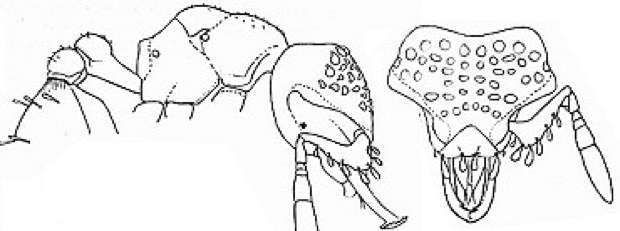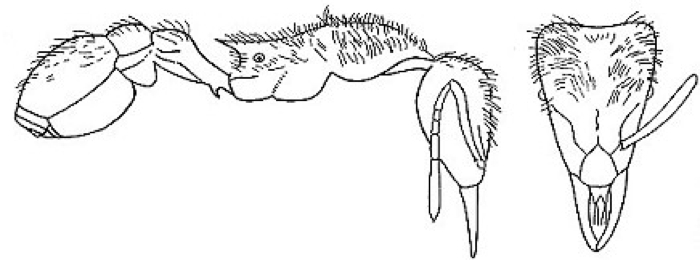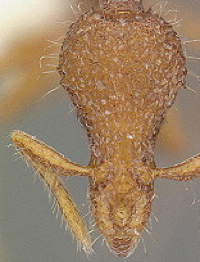SUBFAMILY MYRMICINAE - Genus Pyramica
| The Ants of
Africa SUBFAMILY MYRMICINAE - Genus Pyramica |
|
| Contents - Myrmicinae - MYRMICINAE Introduction |
In Tribe DACETINI
Dacetine Ants - Afrotropical Genera, after Bolton's revision of 1999, separable into those with elongate, linear mandibles, terminating in a fork of two or three spiniform teeth - Strumigenys, Microdaceton, Quadristruma - and those with basically triangular mandibles, some elongate but all without a terminal fork - Pyramica.
Diagnostic Features - Pedicel of two segments, postpetiole
distinctly separated from the gaster, both segments with spongiform or
lamelliform appendages of variable development. Antennae 6-segmented
(4-segmented in a few instances), funiculus with two-segmented club.
Antennal scrobes present. Mandibles basically triangular, even if
elongated, and with a simple, single apical tooth. Roger's (1862a)
genus definition is at - ![]() .
.
An early key to African and Madagascar dacetines is that of Santschi
(1913b). It, with modern annotation, is at ![]() .
.
Bolton (1999) revived the Genus Pyramica Roger and synonymized all the following - Asketogenys, Chelystruma, Cladarogenys, Codiomyrmex, Codioxenus, Dorisidris, Dysedrognathus, Epitritus, Glamyromyrmex, Gymnomyrmex, Kyidris, Neostruma, Pentastruma, Serrastruma, Smithistruma, Tingimyrmex, and Trichoscapa - under this ancient Genus name. Those in bold have Afrotropical members.
Pyramica Roger (1862a: 251).
Type species: Pyramica gundlachi Roger, by monotypy, type
location Cuba.
Pyramica junior synonym of Strumigenys, Roger (1863b:
40), Dalla Torre (1893: 145), Bingham (1903: 147).
Revived from synonymy as a subgenus of Strumigenys by Brown,
W.L. (1948e: 110).
Junior synonym of Strumigenys (Brown, W.L. & Wilson, 1959b:
281), Brown, W.L. (1960c: 37).
Revived from synonymy by Bolton (1999).
Baroni Urbani & De Andrade (2007: 101) postulated that Strumigenys should be the senior synonym of (Afrotropical genera only given here): Cladarogenys, Codiomyrmex, Epitritus, Glamyromyrmex, Miccostruma, Pyramica, Serrastruma, Smithistruma and Trichoscapa. I note this but, as my key objective is the ease of identification, have retained the old genera with two main pages for Strumigenys and here Pyramica.
I find all these revisions by certain taxonomists confusing, to say
the least, and, although perhaps correct, simply irritating for those
with interests wider than narrow museum niceties. Thus, for now, I have
decided to regard the synonymised genera as subgenera and so preserve
recognition of species described in non-taxonomic research publications.
In compiling the key below and the subsidiary, linked, subgenera,
keys, I found that of Bolton (2000: 272 ff) limited in usefulness, at
least for anyone not equipped with a very high quality stereomicroscope
and able to mount tiny ants with, e.g. the mandibles open and the
ventral sides of the head visible. I have followed more simply visible
characters along the lines of the earlier Bolton (1983) keys.
Key to subgenera known from sub-Saharan Africa
| 1 |   Mandibles
elongate and linear Mandibles
elongate and linear |
2 |
| - | Mandibles relatively short | 3 |
| 2 |  Antennal scapes with
a broad, forward-produced, subbasal lobe, head with large orbicular
hairs, clypeus with spatulate or otherwise broad hairs Antennal scapes with
a broad, forward-produced, subbasal lobe, head with large orbicular
hairs, clypeus with spatulate or otherwise broad hairs |
subgenus Epitritus |
| - |  Antennal scapes
linear, head with only simple hairs, including clypeus Antennal scapes
linear, head with only simple hairs, including clypeus |
subgenus Cladarogenys |
| 3 | Mandible with a prominent basal lamella and no more than 17 denticles | 4 |
| - |  Mandible without any
lamella and with >20 denticles Mandible without any
lamella and with >20 denticles |
subgenus Serrastruma |
| 4 | Fully closed mandibles with a distinct transverse border, bases overlapped by clypeus | 5 |
| - |  When fully closed,
mandibles with a strongly defined transverse border, with distinct gap
between it and the clypeal margin; head without hairs; monotypic tramp When fully closed,
mandibles with a strongly defined transverse border, with distinct gap
between it and the clypeal margin; head without hairs; monotypic tramp |
subgenus Trichoscapa |
| 5 |  In profile mandibles
increase in width from base to apex, with apex downcurved In profile mandibles
increase in width from base to apex, with apex downcurved |
subgenus Glamyromyrmex |
| - |   In profile mandibles
near parallel from base to apex, no more than extreme apex downcurved In profile mandibles
near parallel from base to apex, no more than extreme apex downcurved |
subgenus Smithistruma |
| MYRMICINAE Introduction |
© 2007, 2013, 2015 - Brian Taylor CBiol FSB FRES 11, Grazingfield, Wilford, Nottingham, NG11 7FN, U.K. |
href="pyramica.htm"